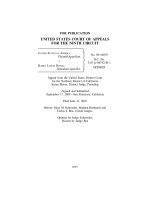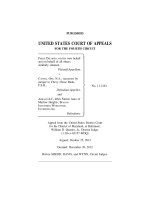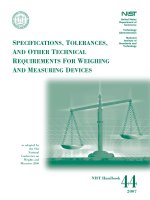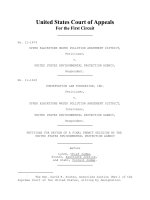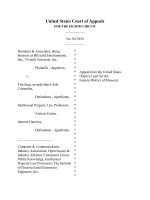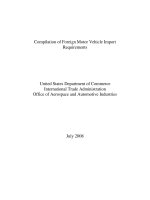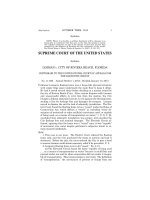United States Department of Agriculture Food Safety and Inspection Service, Office of Public Health Science
Bạn đang xem bản rút gọn của tài liệu. Xem và tải ngay bản đầy đủ của tài liệu tại đây (356.64 KB, 24 trang )
United States Department of Agriculture
Food Safety and Inspection Service, Office of Public Health Science
Page 1 of 24
SOP No: CLG-FLQ2.00
Title: Confirmation of Fluoroquinolone Antibiotics by HPLC Ion Trap Mass Spectrometry
Revision: NA
Replaces: NA
Effective: 01/13/2006
Contents
A.
INTRODUCTION ....................................................................................... 2
B.
EQUIPMENT ............................................................................................. 2
C.
REAGENTS AND SOLUTIONS ................................................................ 3
D.
STANDARDS ............................................................................................ 4
E.
SAMPLE PREPARATION AND CLEANUP............................................... 5
F.
ANALYTICAL PROCEDURE..................................................................... 7
G.
CONFIRMATION..................................................................................... 10
H.
SAFETY INFORMATION AND PRECAUTIONS..................................... 11
I.
QUALITY ASSURANCE PLAN ............................................................... 12
J.
WORKSHEET ......................................................................................... 13
K.
APPENDIX .............................................................................................. 15
L.
APPROVALS AND AUTHORITIES ......................................................... 24
United States Department of Agriculture
Food Safety and Inspection Service, Office of Public Health Science
Page 2 of 24
SOP No: CLG-FLQ2.00
Title: Confirmation of Fluoroquinolone Antibiotics by HPLC Ion Trap Mass Spectrometry
Revision: NA
Replaces: NA
A.
INTRODUCTION
1.
Theory
Effective: 01/13/2006
Fluoroquinolone antibiotics (FLQs) are extracted from homogenized tissue using a
liquid/liquid technique. Upon concentration of the extracts, eight fluoroquinolones are
analyzed by HPLC ion trap mass spectrometry. Two fluoroquinolones (desethylene
ciprofloxacin and desmethyl danofloxacin) are analyzed using HPLC/MS2, whereas six
other fluoroquinolones (difloxacin, enrofloxacin, norfloxacin, danofloxacin, ciprofloxacin,
sarafloxacin) are analyzed by HPLC/MS3.
2.
Applicability
This method confirms desethylene ciprofloxacin, difloxacin, enrofloxacin, norfloxacin,
danofloxacin, desmethyl danofloxacin, ciprofloxacin and sarafloxacin at ≥ 25 ppb in
bovine liver and muscle.
B.
EQUIPMENT
Note: Equivalent equipment may be substituted for that listed below.
1.
2.
Apparatus
a.
Waring Blender - Model BLH 120, Waring Inc.
b.
Robot Coupe® - Model RSI 3Y-1, Robot Coupe Inc.
c.
Centrifuge - Model KR22i, Jouan.
d.
Homogenizer - Model IKA, Ultra Turrax.
e.
Vortex mixer - Fisher-Genie 2.
f.
Pasteur pipettes - borosilicate glass, 5.75 inches.
g.
Nylon syringe filters - 13 mm, 0.22µm disposable, Cat. No. 9445622, Xpertek.
h.
Balance - accurate to 0.0001 g, Cat. No. MT5, Mettler.
i.
Nitrogen evaporator - Turbovap LV, Zymark.
j.
Plasticware - 50 mL polypropylene centrifuge tubes, 30 x115 mm, Cat. No.
352070, Falcon.
k.
Autosampler vials - 750 µL, plastic, Cat. No. 951501, Xpertek.
l.
Micropipetters - covering the range from 10 µL – 5000 µL.
m.
Vibrax mixer - Model VX8, Janke & Kunkel.
n.
Balance - accurate to 0.01 g, Cat. No. PB302, Mettler.
Instrumentation
a.
Ion trap mass spectrometer - Finnigan LCQ-deca equipped with an APCI LC
United States Department of Agriculture
Food Safety and Inspection Service, Office of Public Health Science
Page 3 of 24
SOP No: CLG-FLQ2.00
Title: Confirmation of Fluoroquinolone Antibiotics by HPLC Ion Trap Mass Spectrometry
Revision: NA
Replaces: NA
Effective: 01/13/2006
interface and Windows NT ver.4.0- LCQ Xcalibur data system, or equivalent.
C.
b.
LC system - Quaternary pump equipped with degassing capability and
autosampler.
c.
LC column - Phenyl 3 x 150 mm containing 3.5 µm particles, Cat. No. XDB,
Zorbax.
d.
Guard column - 2.1 mm x 12.5 mm containing 5 µm particles, Eclipse XDB-C8.
REAGENTS AND SOLUTIONS
Note: Equivalent reagents and solutions may be substituted for the following unless
otherwise indicated:
1.
2.
Reagents
a.
Ethyl ether - ACS Grade, 99%, Aldrich.
b.
Water, LC grade - House distilled water passed through Waters MilliQ
deionization system.
c.
Acetonitrile - UV Grade, Cat. No. 015-4, Burdick & Jackson.
d.
Sodium chloride - ACS Grade, Cat. No. 3624-01, Baker.
e.
Ammonium hydroxide 28% - Cat. No. 38,053-9, Aldrich.
f.
Hexane - Omnisolv. Cat. No. HX0296-1, EM.
g.
Sodium phosphate dibasic, heptahydrate - ACS Grade, Cat. No. S-9390, Sigma.
h.
Formic acid - ACS Grade, Cat. No. F-4636, Sigma.
i.
Sodium phosphate monobasic, monohydrate - ACS Grade, Cat. No. S-9638,
Sigma.
j.
Sodium hydroxide - ACS Grade.
k.
Methanol - HPLC grade, Mallinckrodt.
Solutions
a.
1M sodium chloride solution:
Transfer 58.45 g NaCl to a 1000 mL volumetric flask. Dissolve and dilute to
volume with water.
b.
0.2M monobasic sodium phosphate monohydrate:
Transfer 27.6 g NaH2PO4 to a 1000 mL volumetric flask. Dissolve and dilute to
volume with water. Stable for 6 months at 2-8 ºC.
c.
0.2M dibasic sodium phosphate heptahydrate:
Transfer 53.65 g Na2HPO4 to a 1000 mL volumetric flask. Dissolve and dilute to
volume with water. Stable for 6 months at 2-8 ºC.
United States Department of Agriculture
Food Safety and Inspection Service, Office of Public Health Science
Page 4 of 24
SOP No: CLG-FLQ2.00
Title: Confirmation of Fluoroquinolone Antibiotics by HPLC Ion Trap Mass Spectrometry
Revision: NA
d.
Replaces: NA
Effective: 01/13/2006
30% sodium hydroxide:
Transfer 60 g NaOH to a 200 mL volumetric flask and dilute to volume with
water. Stable for 6 months at 2-8 ºC.
e.
0.1M phosphate buffer, pH 9.0 (Buffer A):
Transfer 27 mL of 0.2M monobasic sodium phosphate monohydrate (a) and 473
mL of 0.2M dibasic sodium phosphate heptahydrate (b) to a 1000 mL beaker.
Add water to approx. 900 mL. Adjust to pH 9.0 with 30% NaOH (c). Transfer to
a 1000 mL volumetric flask and dilute to volume with water. Stable for 6 months
at 2-8 ºC.
f.
0.03M sodium hydroxide:
Transfer 1.2 g NaOH to a 1000 mL volumetric flask and dilute to volume with
water.
g.
Mobile phase A (15/85 acetonitrile/water containing 1% formic acid):
To a 1000 mL graduated cylinder add 150 mL acetonitrile and 840 mL water.
Mix and add 10 mL formic acid. Mix well.
h.
Mobile phase B (20/80 acetonitrile/water containing 1% formic acid ):
To a 1000 mL graduated cylinder add 200 mL acetonitrile and 790 mL water. Mix
and add 10 mL formic acid. Mix well.
i.
Mobile phase C (80/20 acetonitrile/water containing 1% formic acid):
To a 1000 mL graduated cylinder add 800 mL acetonitrile and 190 mL water.
Mix and add 10 mL formic acid. Mix well.
j.
Mobile phase D (60/40 acetonitrile/water):
To a 1000 mL graduated cylinder add 600 mL acetonitrile and 400 mL water.
Mix well.
D.
STANDARDS
Note: Equivalent standards and solutions may be substituted for any of the following:
1.
Source
a.
Desethylene ciprofloxacin:
Bayer Corp., West Haven, CT.
b.
Difloxacin HCl:
Abbott Labs, North Chicago, IL.
c.
Enrofloxacin:
Bayer Corp., West Haven, CT.
d.
Norfloxacin:
Sigma-Aldrich, St. Louis, MO.
e.
Ciprofloxacin:
United States Pharmacopoeia (USP).
f.
Desmethyl danofloxacin:
Pfizer Pharmaceuticals, Groton, CT.
g.
Sarafloxacin HCl:
Abbott Labs, North Chicago, IL.
United States Department of Agriculture
Food Safety and Inspection Service, Office of Public Health Science
Page 5 of 24
SOP No: CLG-FLQ2.00
Title: Confirmation of Fluoroquinolone Antibiotics by HPLC Ion Trap Mass Spectrometry
Revision: NA
h.
Replaces: NA
Danofloxacin Mesylate:
Effective: 01/13/2006
Pfizer Pharmaceuticals, Groton, CT.
Note: Chemical structures of fluoroquinolones available in Appendix K.3.
2.
Preparation
a.
Individual drug stock standard solutions (100 µg/mL):
Using vendor's stated purity, or water and salt content, calculate the amount of
material which contains 5 mg drug. Weigh out approximately this amount,
accurately recording weight to nearest 0.1 mg. Transfer to 50 mL glass
volumetric flask and dilute to mark with 0.03M NaOH (C.2.f). Calculate exact
concentration based on purity and actual weight. Stable for 6 months at 2-8 ºC.
b.
Mixed working standard solution (2 µg/mL):
Add 1.0 mL of each of the above drug stock solutions to a 50 mL volumetric flask
and dilute to mark with Buffer A (C.2.e.). Stable for 1 month at 2-8 ºC.
c.
External standard solution (12.5 ng/mL):
Transfer 12.5 µL of the Mixed working standard solution (b) to a 50 mL plastic
centrifuge tube and add 2.0 mL of Buffer A (C.2.e). Prepare daily.
d.
System suitability standard (12.5 ng/mL):
Transfer 12.5 µL of the mixed working standard solution (b) to a 50 mL plastic
centrifuge tube and add 2.0 mL of methanol. Prepare daily.
E.
SAMPLE PREPARATION AND CLEANUP
1.
Sample Handling and Preparation:
a.
Freshly collected samples must be kept cold before and during shipping to
laboratory. Once received at laboratory, samples must be frozen (< -10 ºC) prior
to processing if they cannot be prepared on the day of receipt.
b.
If sample is frozen, allow to thaw, but keep as cold as possible. Dissect away fat
and connective tissue from liver and muscle. Homogenize liver in a Waring
blender and muscle in a Robot Coupe®.
Note: After each homogenization, rinse the blending jars with tap water and dry.
United States Department of Agriculture
Food Safety and Inspection Service, Office of Public Health Science
Page 6 of 24
SOP No: CLG-FLQ2.00
Title: Confirmation of Fluoroquinolone Antibiotics by HPLC Ion Trap Mass Spectrometry
Revision: NA
2.
Replaces: NA
Effective: 01/13/2006
Extraction and Cleanup:
a.
Weigh 1.0 ± 0.10 g of homogenized tissue into a 50 mL disposable
polypropylene centrifuge tube.
Note: Prepare controls (to be included as part of each sample batch) at this
time:
i.
Negative controls are tissues from animals known to be free of drugs. If
these are not available, tissue from an unknown source may be used
provided it is first tested and shown to be free of contaminants.
ii.
Positive controls are negative tissues that have been fortified with
fluoroquinolones before extraction. To prepare a 25 ppb fortified sample,
add 12.5 µL of a 2 µg/mL mixed drug solution (D.2.b) to 1 g tissue and
vortex 30 min on a Vibrax mixer. Store in a dark cabinet (room temp.) for
0.5 hr to allow time for the FLQ’s to interact with matrix.
b.
Add approx. 3 mL acetonitrile and 0.25 mL conc. ammonium hydroxide to each
tube.
c.
Homogenize tube contents for approx. 20 sec. Rinse homogenizer tip with
approx. 0.5 mL of acetonitrile directly into the sample tube. Centrifuge at
approximately 5000 rpm (2800 g.) for 10 min.
d.
Decant supernatant into another 50 mL polypropylene centrifuge tube.
e.
Add 0.75 mL of water to the pellet from the centrifugation and repeat steps b-c,
adding the supernatant to the tube in step d.
f.
Add approx. 3 mL ethyl ether, 3 mL hexane and 0.25 mL 1M NaCl to the
combined supernatants for each sample.
g.
Vortex the tubes for 15 sec.
h.
Using a disposable Pasteur pipette, remove as much of the top layer as possible
and discard. There may be 3 layers at this point but discard only the uppermost
layer.
i.
Evaporate the combined organic solution to near dryness (approximately 200 µL)
in a Turbovap maintained at approximately 50 ºC.
j.
Add 2.0 mL Buffer A (C.2.e) to each tube and vortex for approx 10-20 sec. Filter
contents through a 0.2 µm nylon syringe filter into an autosampler vial.
United States Department of Agriculture
Food Safety and Inspection Service, Office of Public Health Science
Page 7 of 24
SOP No: CLG-FLQ2.00
Title: Confirmation of Fluoroquinolone Antibiotics by HPLC Ion Trap Mass Spectrometry
Revision: NA
F.
Replaces: NA
Effective: 01/13/2006
ANALYTICAL PROCEDURE
Note: Instrumental parameters yielding equivalent analytical results may be used.
1.
Instrument Operating Parameters – LC System:
Note: Typical values listed below. Flows and elution gradient may be optimized, if
necessary, for best separation and response.
a.
Install and degas mobile phases and install column and guard cartridge per
manufacturers' instructions. Flush HPLC column with 20 column volumes
(35 mL) of methanol, water, and 60/40 acetonitrile/water (C.2.j) prior to further
use of the column. Set initial composition to flow 15/85 acetonitrile/water
containing 1% formic acid (C.2.g) at 500 µL/min.
b.
Set up the HPLC to run the following gradient:
Time in
min.
0.00
Flow in
mL/min.
0.50
Mobile Phase
A*
100%
Mobile Phase
B*
0%
Mobile Phase
C*
0%
10.00
0.50
100%
0%
0%
18.00
0.50
0%
100%
0%
20.00
0.50
0%
100%
0%
22.00
0.50
0%
0%
100%
24.00
0.50
0%
0%
100%
27.00
0.50
100%
0%
0%
30.00
0.50
100%
0%
0%
A* = C.2.g,
B* = C.2.h,
C* = C.2.i.
c.
Set injection volume to 20 µL.
d.
Use a needle wash step with methanol or water.
United States Department of Agriculture
Food Safety and Inspection Service, Office of Public Health Science
Page 8 of 24
SOP No: CLG-FLQ2.00
Title: Confirmation of Fluoroquinolone Antibiotics by HPLC Ion Trap Mass Spectrometry
Revision: NA
2.
3.
Replaces: NA
Effective: 01/13/2006
Instrument Operating Parameters – Mass Spectrometer:
a.
Calibrate the Finnigan LCQ ion trap mass spectrometer with APCI interface
according to the manufacturer's specifications.
b.
Set Capillary Temp to 200 °C.
c.
Operate in Pos mode.
d.
Flow inject the system suitability standard through a 5 µL loop and obtain the
MS1 precursor ion centroids. The following settings should result in optimal ion
intensities:
Capillary temperature
200 °C
APCI vaporizer temperature
470 °C
Sheath gas flow
50
Aux gas flow
5
Capillary voltage
2V
Tube lens offset
-5 V
Micro scans
2
Ion time
100 msec
Source current
5.00 µA
Procedure for Instrumental Analysis of Samples, Controls, and Standards:
a.
Turn on pump and set up mass spectrometer. Equilibrate column in mobile
phase at 0.5 mL/min for at least 30 min.
b.
Flow inject the system suitability standard through a 5 µL loop and obtain the
MS1 precursor centroids. Using the MS1 mass assignments previously obtained,
flow inject a sample under MS/MS conditions for each analyte and obtain the
MS2 precursor ion centroids and accompanying collision energies.
c.
Inject the external standard through the HPLC system and determine the
retention times of each FLQ. Isolate each peak within a suitable window for
acquisition. After setting in the window segments, monitor the following ion
transitions:
United States Department of Agriculture
Food Safety and Inspection Service, Office of Public Health Science
Page 9 of 24
SOP No: CLG-FLQ2.00
Title: Confirmation of Fluoroquinolone Antibiotics by HPLC Ion Trap Mass Spectrometry
Revision: NA
Replaces: NA
Effective: 01/13/2006
Fluoroquinolone
Scan Program
Trans.
Amp
Q
Time
IsoW
Desethylene Cip.
306→(80-310)
MS2
35%
0.250
30
2.0
2
MS
30%
0.350
30
2.0
MS3
35%
0.250
30
2.0
2
MS
35%
0.350
30
2.0
MS3
35%
0.250
30
2.0
2
MS
35%
0.350
30
2.0
MS3
35%
0.250
30
2.0
2
Norfloxacin
Ciprofloxacin
Danofloxacin
320→276→(75-330)
332→288→(75-340)
358→314→(85-370)
Desmethyl-Dano.
344→(90-350)
MS
40%
0.250
30
2.0
Enrofloxacin
360→316→(85-370)
MS2
40%
0.350
30
2.0
3
MS
35%
0.250
30
2.0
MS2
35%
0.350
30
2.0
3
MS
38%
0.250
30
2.0
MS2
38%
0.350
30
2.0
3
35%
0.250
30
2.0
Sarafloxacin
Difloxacin
386→342→(90-400)
400→356→(95-410)
MS
d.
Inject the recovered standard and verify retention time, divert valve switching
time, and spectral comparison to the external standard.
e.
Inject the sample extracts. In order to control carryover, precede each sample
analysis with a blank buffer injection as needed.
f.
As a test of retention time and instrument response stability, reinject the spiked
control extract and one or more chromatographic standards at the end of the
sample set. Depending on instrument variability and length of sample set,
additional spiked control extract or standard injections may be interspersed
throughout the sample set.
g.
Column, Pump, and APCI Interface Care: At the end of set of analyses, flush the
column for 30 min with mobile phase D (60/40 acetonitrile/water) at 0.50 mL/min.
United States Department of Agriculture
Food Safety and Inspection Service, Office of Public Health Science
Page 10 of 24
SOP No: CLG-FLQ2.00
Title: Confirmation of Fluoroquinolone Antibiotics by HPLC Ion Trap Mass Spectrometry
Revision: NA
Replaces: NA
Effective: 01/13/2006
G.
CONFIRMATION
1.
Data Processing. Use the QUAL Browser to view total ion current, base ion
chromatogram, and/or a total ion chromatogram (TIC) for each drug for each data file.
Note retention time of any visible peaks in a drug window. Generate averaged spectra
across the retention time window for each drug. This is usually from near the start to
near the end of the peak visible in the chromatograms, though a smaller range may be
used to avoid a spurious ion spike. Where no peak is visible, use the same settings as in
a contemporaneous fortified or positive control extract.
2.
Confirmation Criteria:
a.
Retention times of extract peaks in one or more of the ion chromatograms must
match the peak retention time of a contemporaneous (within same analysis set
on same day) fortified control extract chromatogram within ± 4%.
b.
The FLQ peak in the total ion chromatogram (TIC) (see below for ions used for
each drug TIC) is present at a S/N ratio of at least 3/1. This is estimated by visual
inspection of the TIC.
c.
The spectrum from the extract must visually match spectra from external
standards in the same data set. The base ion must be the same. At least two
qualifying ions should be present, readily distinguished from background ions,
and have relative abundances comparable to those in the standard. There should
be a general absence of nonspecific ions.
Major specific ions for each FLQ are listed below:
Fluoroquinolone
Desethylene cip.
Precursor
ion(s)
306
Spectra
Range
80-310
Base
ion
306
289, 286, 263
Norfloxacin
320, 276
75-330
256
257, 233, 219
Ciprofloxacin
332, 288
75-340
268
245, 231, 205
Danofloxacin
358, 314
85-370
294
283, 245, 219
344
90-350
344
327, 300, 283
Enrofloxacin
360, 316
85-370
245
296, 288, 268
Sarafloxacin
386, 342
90-400
322
299, 285, 281
Difloxacin
400, 356
95-410
299
336, 311, 285,
Desmethyl dano.
d.
Qualifying Ions
The quality assurance positive and negative control samples confirm and fail to
confirm, respectively, for the presence of the appropriate drug.
United States Department of Agriculture
Food Safety and Inspection Service, Office of Public Health Science
Page 11 of 24
SOP No: CLG-FLQ2.00
Title: Confirmation of Fluoroquinolone Antibiotics by HPLC Ion Trap Mass Spectrometry
Revision: NA
3.
Replaces: NA
Effective: 01/13/2006
Criteria for Repeating an Analysis:
Note: Sample analyses may be repeated under the following conditions:
a.
The conditions described in G.2.d are not met.
b.
The instrument is suspected to be malfunctioning, as demonstrated by clearly
aberrant standard spectra; failure of a calibration check performed shortly after
analysis of the sample set; instrumental parameters, especially vacuum readings,
outside of normal operating range; or other conditions noted and documented by
the analyst.
c.
There is suspected carryover from a previous high concentration sample or
standard. In this case, the sample should be reanalyzed after the cause of the
carryover has been identified and measures taken to prevent its reoccurrence.
d.
There is strong evidence of FLQ presence, but multiple extraneous ions with
relative abundance exceeding that of the FLQ base ion prevent unambiguous
confirmation. In this case, it may be appropriate to reanalyze the suspected
positive sample together with a chromatographic standard, and negative and
positive QA controls.
H.
SAFETY INFORMATION AND PRECAUTIONS
1.
Required Protective Equipment — Safety glasses, disposable gloves, lab coats.
2.
Hazards:
Procedure Step
Hazard
Recommended Safe Procedures
Acetonitrile, Hexane
Highly flammable and
toxic liquid. May cause
skin irritation.
Use in a fume hood away from all
electric devices and open flames.
Avoid breathing vapors.
Formic acid and
solutions made from
same. Conc.
NH4OH
Corrosive. Danger of
chemical burns.
Prepare solutions in a fume hood.
Wear PPE and avoid contact with
skin.
Ethyl ether
Highly flammable. May
detonate due to formation
of peroxides.
Order only as much as needed for
three months of testing. Test for
peroxides before use and monthly
thereafter. Discard this solvent
upon discontinuation of the project.
United States Department of Agriculture
Food Safety and Inspection Service, Office of Public Health Science
Page 12 of 24
SOP No: CLG-FLQ2.00
Title: Confirmation of Fluoroquinolone Antibiotics by HPLC Ion Trap Mass Spectrometry
Revision: NA
3.
Replaces: NA
Effective: 01/13/2006
Disposal Procedures:
Procedure Step
Hazard
Recommended Safe Procedures
Acetonitrile, Hexane
See section 2 above.
Collect waste in a sealed container
and store in a cool, well ventilated,
flammable liquid storage
area/cabinet for disposal in
accordance with local, state and
federal regulations.
Acids and acidic
reagents
See section 2 above.
Collect waste in a sealed container
and store in a cool, well ventilated,
acid liquid storage area/cabinet for
disposal in accordance with local,
state and federal regulations.
Bases and basic
reagents
See section 2 above.
Collect waste in a sealed container
and store in a cool, well ventilated,
base liquid storage area/cabinet for
disposal in accordance with local,
state and federal regulations.
Ethyl ether
See section 2 above.
Collect waste in a separate
container. Waste will be disposed
of in an alternate manner.
I.
QUALITY ASSURANCE PLAN
1.
Performance Standard
Refer to Section G.2 for Confirmation Criteria.
2.
Readiness To Perform (FSIS Training Plan):
a.
Familiarization:
i.
Phase I: Standards - Inject external standard solutions (D.2.c.) in
duplicate on at least three different days and verify instrument response is
adequate for confirmatory purposes.
ii.
Phase II: Fortified samples - Analyze on three separate days, one blank
bovine liver, one fortified bovine liver at 25 ppb, one blank bovine muscle,
and one fortified bovine muscle at 25 ppb.
NOTE: Phase I and Phase II may be performed concurrently.
iii.
Phase lll: Check samples for analyst accreditation.
(a)
6 check samples fortified at levels between 1-2 times Minimum
Proficiency Level (MPL) using analytes and concentrations
United States Department of Agriculture
Food Safety and Inspection Service, Office of Public Health Science
Page 13 of 24
SOP No: CLG-FLQ2.00
Title: Confirmation of Fluoroquinolone Antibiotics by HPLC Ion Trap Mass Spectrometry
Revision: NA
Replaces: NA
Effective: 01/13/2006
unknown to the analyst. These six unknowns shall be composed
of three bovine liver and three bovine muscle tissues and at least
one check sample should be blank . Each set must include a
positive control and a negative control.
(b)
b.
Notification from QAM is required to analyze official samples.
Acceptability criteria:
Refer to I. 1.
3.
Intralaboratory Check Samples
a.
b.
System, minimum contents:
i.
Frequency: One per week per analyst when samples analyzed.
ii.
Records are to be maintained for review.
Acceptability criteria:
If unacceptable values are obtained, then:
4.
5.
i.
Stop all official analyses by that analyst.
ii.
Investigate and identify probable cause.
iii.
Take corrective action.
Sample Acceptability and Stability:
a.
Matrices: Bovine liver and muscle.
b.
Condition upon receipt: chilled or frozen, minimum weight is 50 grams.
c.
Sample storage:
i.
Time: 2 weeks for blended/homogenized samples.
ii.
Condition: Frozen (less than -10 ºC).
Sample Set:
a.
Negative liver/muscle control sample (E.2.a.i.). QA samples are to be of the
same species and tissues as the samples analyzed.
b.
Positive liver/muscle control sample (E.2.a.ii.). QA samples are to be of the
same species and tissues as the samples analyzed.
c.
Samples.
6.
Minimum Proficiency Level: 25 ppb.
J.
WORKSHEET
The following worksheet is an example:
United States Department of Agriculture
Food Safety and Inspection Service, Office of Public Health Science
Page 14 of 24
SOP No: CLG-FLQ2.00
Title: Confirmation of Fluoroquinolone Antibiotics by HPLC Ion Trap Mass Spectrometry
Revision: NA
Replaces: NA
Effective: 01/13/2006
United States Department of Agriculture
Food Safety and Inspection Service, Office of Public Health Science
Page 15 of 24
SOP No: CLG-FLQ2.00
Title: Confirmation of Fluoroquinolone Antibiotics by HPLC Ion Trap Mass Spectrometry
Revision: NA
Replaces: NA
K.
APPENDIX
1.
Reference:
Effective: 01/13/2006
Schneider, M. J., Donoghue, D. J. (2002), J. Chromatogr. B 780, 83-92.
2.
Chromatograms and Spectra:
The following chromatograms and spectra are shown on the next 3 pages:
a.
External standards at 25 ppb.
b.
Blank Beef liver.
c.
Beef Liver Recovery at 25 ppb.
United States Department of Agriculture
Food Safety and Inspection Service, Office of Public Health Science
Page 16 of 24
SOP No: CLG-FLQ2.00
Title: Confirmation of Fluoroquinolone Antibiotics by HPLC Ion Trap Mass Spectrometry
Revision: NA
Replaces: NA
Effective: 01/13/2006
United States Department of Agriculture
Food Safety and Inspection Service, Office of Public Health Science
Page 17 of 24
SOP No: CLG-FLQ2.00
Title: Confirmation of Fluoroquinolone Antibiotics by HPLC Ion Trap Mass Spectrometry
Revision: NA
Replaces: NA
Effective: 01/13/2006
United States Department of Agriculture
Food Safety and Inspection Service, Office of Public Health Science
Page 18 of 24
SOP No: CLG-FLQ2.00
Title: Confirmation of Fluoroquinolone Antibiotics by HPLC Ion Trap Mass Spectrometry
Revision: NA
Replaces: NA
Effective: 01/13/2006
United States Department of Agriculture
Food Safety and Inspection Service, Office of Public Health Science
Page 19 of 24
SOP No: CLG-FLQ2.00
Title: Confirmation of Fluoroquinolone Antibiotics by HPLC Ion Trap Mass Spectrometry
Revision: NA
3.
Replaces: NA
Structures of Fluoroquinolones:
Effective: 01/13/2006
United States Department of Agriculture
Food Safety and Inspection Service, Office of Public Health Science
Page 20 of 24
SOP No: CLG-FLQ2.00
Title: Confirmation of Fluoroquinolone Antibiotics by HPLC Ion Trap Mass Spectrometry
Revision: NA
4.
Replaces: NA
Effective: 01/13/2006
Proposed Fragmentation Patterns of Fluoroquinolones:
a.
Ciprofloxacin, Sarafloxacin, Norfloxacin, and Enrofloxacin
United States Department of Agriculture
Food Safety and Inspection Service, Office of Public Health Science
Page 21 of 24
SOP No: CLG-FLQ2.00
Title: Confirmation of Fluoroquinolone Antibiotics by HPLC Ion Trap Mass Spectrometry
Revision: NA
Replaces: NA
b.
Desethylene ciprofloxacin
c.
Desmethyl danofloxacin
Effective: 01/13/2006
United States Department of Agriculture
Food Safety and Inspection Service, Office of Public Health Science
Page 22 of 24
SOP No: CLG-FLQ2.00
Title: Confirmation of Fluoroquinolone Antibiotics by HPLC Ion Trap Mass Spectrometry
Revision: NA
d.
Replaces: NA
Danofloxacin
Effective: 01/13/2006
United States Department of Agriculture
Food Safety and Inspection Service, Office of Public Health Science
Page 23 of 24
SOP No: CLG-FLQ2.00
Title: Confirmation of Fluoroquinolone Antibiotics by HPLC Ion Trap Mass Spectrometry
Revision: NA
e.
Replaces: NA
Difloxacin
Effective: 01/13/2006
United States Department of Agriculture
Food Safety and Inspection Service, Office of Public Health Science
Page 24 of 24
SOP No: CLG-FLQ2.00
Title: Confirmation of Fluoroquinolone Antibiotics by HPLC Ion Trap Mass Spectrometry
Revision: NA
Replaces: NA
L.
APPROVALS AND AUTHORITIES
1.
Approved By:
Effective: 01/13/2006
Terry Dutko
Michael Lankford
Jess Rajan
Phyllis Sparling
*Charles Pixley
Approvals on file.
2.
*Issuing Authority: Laboratory Quality Assurance Division (LQAD).
